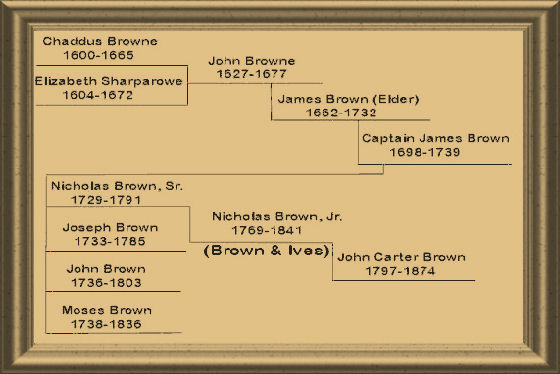![]()
Postal History Introduction
Stampless
Covers
1846
to 1900 Issues
1901-1950
Issues
1951-2003
Issues
Cancels
&
Miscellaneous
Postal
Stationery
Post
Cards
Air
Mail
First
Day &
Event Covers
Parcel Post/Special Delivery
Registered & Official Mail
Commercial & Advertising
Revenue & Postage Due
Wildlife & Game Issues
Complete List of RI Issues
|
Rhode Island Stampless
Covers & Letters |
|
|
|
|
The Progenitor of the Brown family in America; Reverend Chad Brown (or Chaddus Browne) arrived at Boston in the Massachusetts Bay Colony in July of 1638 aboard the ship "Martin" with his wife Elizabeth and young son John. Chaddus Browne was born in High Wycombe, Buckinghamshire, England around 1600. He married Elizabeth Sharparowe of Melbourne, Bedfordshire, England on September 11, 1626. Chad Brown and his family moved to Providence, Rhode Island shortly after arriving in Boston, where along with Roger Williams and others he was a signer of the Rhode Island Compact which denied religious interference in civil affairs. In 1642 Chad Brown was ordained as pastor of the First Baptist Church of Providence. There has been some controversy as to whether Chad or Roger Williams was the first pastor of the church, however Reverend Brown was most certainly the first ordained minister of the church. The oldest authority available; "The History of the Baptists in America" published in 1772 by Morgan Edwards states, "Williams was pastor from the establishment of the church until he left the colony for England in 1643, and he then resigned it to Messers. Brown and Wickenden. Mr. Chad Brown died between 1660 and 1665 leaving the church in charge of his colleague." Chad Brown's home was located at the corner of Market Square and College Street, (Brown University now occupies a portion of this property). He was originally buried on his own property and his remains were later relocated to the North Burial Ground in 1792. The inscription on his tombstone reads as follows: "In Memory of Chad Brown Elder of the Baptist Church in this town. He was one of the original Proprietors of the Providence Purchase Having been exiled from Massachusetts for Conscience Sake. He had five sons John, James, Jeremiah, Chad and Daniel who have left a numerous Posterity. He died about A. D. 1665. This Monument was erected by the Town of Providence." Chad's oldest son John, who was born in England and made the voyage on the Martin to Boston with his family was born in 1630. He married Mary Holmes of Lancashire, England in 1654 in Providence, Rhode Island. Their son, James Browne, (Elder) was born May 18, 1662 in Providence, Rhode Island. He married Mary Harris and their son Captain James Brown, Jr. was born on March 22, 1698 in Providence, Rhode Island. Captain James Brown and his brother Obadiah established the basis of the family fortune. James was the first Brown to enter the slave trade in 1736 with his sloop "Mary" under the command of Captain John Godfrey with his younger brother Obadiah acting as the Supercargo. Obadiah raised the four sons of his brother James after he died suddenly in 1739. Those four sons later became known as the famous "Four Brothers" of Providence. They were Nicholas (Sr.), Joseph, John, and Moses. Obadiah established the firm of Obadiah Brown & Co. with Moses Brown in 1750. Nicholas, John and Joseph joined the firm later on. After Obadiah died in 1762, Nicholas and his three brothers continued in business as Nicholas Brown & Co., which became Brown and Benson when George Benson joined the firm in 1783; then Brown, Benson and Ives in 1792 and under his son Nicholas Jr.; Brown and Ives in 1796. The Four Brothers Nicholas Brown, Sr. Joseph Brown John Brown John Brown was the first Rhode Islander to become engaged in the "China Trade." His ship "General Washington" departed from Rhode Island bound for the "Far East" on December 27, 1787 arriving in Whampoa, China on October 27, 1788. The firm of Brown, Benson and Ives had helped finance John's Far Eastern ventures and after noting the vast profits to be made, entered the China trade on their own in 1792 with their ship "Rising Sun." John married Sarah Smith on November 27, 1760 and died in Providence on September 20, 1803. Moses Brown Moses was an early participant in the textile industry. He formed a company with his son in law, William Almy, (Almy & Brown) in 1789 for the manufacture of cotton cloth. He became interested in the advanced techniques employed in England by the Arkwright Mills and paid the passage for Samuel Slater to come to America and build one of the new style mills for Almy & Brown. This mill built in Pawtucket, RI was the first water-powered mill in America. Moses also helped to found the Providence Bank in 1791. In 1770 Moses helped to bring Rhode Island College (Brown University) to Providence. He also worked diligently to establish a Quaker school and in 1819, the "New England Yearly Meeting Boarding School," (renamed Moses Brown School in 1904) was established. |
|
|
GO TO PAGE TWO - Brown & Ives - 1792 to 1874 |

RI Historical
Society
Introduction
Stampless I
Stampless II
Stampless III
Stampless IV
Stampless V
Stampless VI
Brown & Ives Letters
The Hazard Family Letters
Joseph Tillinghast
Free Franked Letters
DeWolf Family Letters
Recently Added Pages
GO TO PAGE TWO
1792 to 1874
